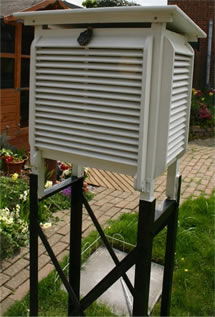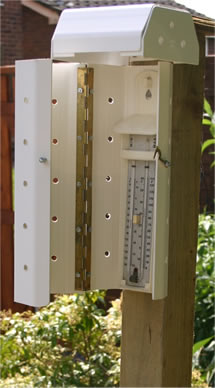Weather Boxes
You will need some sort of a box to protect some of your instruments and to keep the direct sun, rain and wind off them. You will need to have a special sort of box to put instruments in so that you can compare your measurements to other people's.
So that all weather boxes match, the outsides are white and they often have slats or louvres so that the air can circulate whilst the rain and direct wind is kept out. They need a double roof and a double floor. The weather box should be placed so that the bulbs of the thermometers (or sensors) are 1.25 meters above the ground.
This is important to make it so that you can compare your weather data to other people's weather data. If you are very lucky you will be able to afford a Stevenson Screen. If not, don't give up. This page has details of how you could easily and cheaply make a weather box to keep your instruments in. Although they are not as good as a real Stevenson Screen, they will give you a chance to collect some useful data. If you do use any of the instructions to make your own weather box, please send us a photograph of it when it is installed! These homemade weather box instructions are simply guides. They are intended to be made by adults taking sensible safety precautions. The user is responsible for his/her own well being and safety.
To see more about where to put your weather station items see Setting up your Weather Station and More About Setting up your Weather Station. This page will also show you where to put your weather vane and rain gauge. There is also a page on Weather Apparatus to help you select the instruments you want to use.
Weather box - large digitalWork is in progress on the design of a new weather box. This will be bigger than the wooden digital box featured on this page. The aim is to allow for more effective air circulation. It will be similar to the wooden deluxe weather box design, but with some useful modifications. A prototype (as yet unpainted) has now been constructed, and the next version is being constructed. See the box with and without its digital thermometer. The external measurements are approximately 27 x 19 x 37cm. |
 |
Stevenson Screen - woodenA purpose made wooden Stevenson Screen with its metal stand is very expensive but very effective. There is plenty of room inside for all of the instruments you need. The louvred sides are double so that no rain or wind can get in. All of the instruments will be shaded from direct sunlight. The thermometers are at the correct height, so that data can be compared with data from other Stevenson Screens. This example is made of wood, and needs regular maintenance. It also needs cleaning regularly. See more about this type of screen at Russell Scientific or do a search on the web. |
|
Stevenson Screen - modernSome modern Stevenson screens are made of durable materials and do not need painting. The one on the right is made of polyester powder coated aluminium and modern plastics. It does not need painting and will not go yellow. It has double louvres so that rain, sunlight and draughts cannot get inside and affect the readings. It also has a double roof and floor. |
|
This smaller Stevenson screen can be bought ready made or can be bought in kit form. It has room for a maximum and minimum thermometer, and a wet and dry thermometer. You can see it open on the Setting up Your Weather Station page. It keeps your instruments shaded, but allows the air to move freely round the thermometers. You can buy a kit from the Weather Shop in the UK (in the 'instrument screen' section). A ready-made one can be bought from Metcheck. (Check the measurements of your instruments to see if they are suitable.) To find more places to purchase them search online for 'Stevenson screen' or 'instrument screen'. |
 |
Weather box - wooden double deluxeThis is a deluxe weather box because it has double layers so that the wind and rain are inhibited from getting into the box. The holes are arranged so that there is no direct path for rain and wind. Any rain that gets through the outer set of holes is able to drain out of the bottom of the box. It is a little harder to make that the double wooden box below. It is not as expensive to make as the one made using vents. See the outside of the box here. |
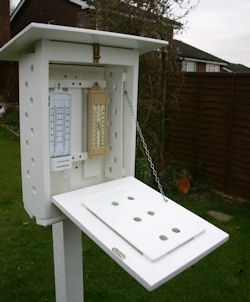 |
Weather box - double combination vents and woodThis box combines the advantages of the plastic vents and the ease of using wood for the sides of the box. |
 |
Weather box - with vents horizontal ventsThis weather box is an improvement on the weather box below. It has vents all round but the vents have been altered so that they can all be horizontal. this is better for stopping rain and wind from getting into the box. It provides just the right amount of ventilation. The construction is very similar to the one below. You can see the box open here. |
 |
Weather box - home made using ventsThis weather box is a little complicated to make but well worth the effort. The finished box is roomy and the double louvres are similar to the ones on expensive bought boxes. The materials will cost a little more than the boxes below as the vents are quite expensive. See how to make it in the weather_box_louvred file. Remember that your weather box is meant to be white. You might need to wipe it clean occasionally. |
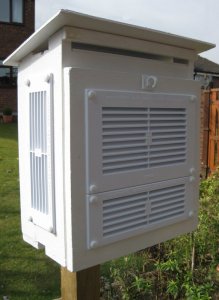 |
Weather box - basic made from woodThis weather box has been easily constructed from one piece of wood. It does require some ability to measure, saw and drill. It also requires painting (including a primer and an undercoat). Although it may require some maintenance, it should last for quite a while. There is room inside for a maximum and minimum Thermometer. See how to make it in the weather_box_basic file. Remember to position the box at the correct height. Check for more details about where you should position your weather box on the Setting Up page. |
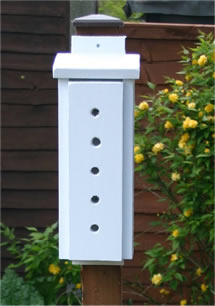 |
Weather box - double wooden version...This weather box needs a little more skill, but still can be made fairly easily. It will provide room for both a maximum and minimum thermometer and a wet and dry thermometer. This one is ideal for keeping your basic instruments in. See how to make it in the weather_box_double file. Remember to open and close the door gently, so as not to damage the instruments. Check for more details about how you should position your weather box on the Setting Up page. |
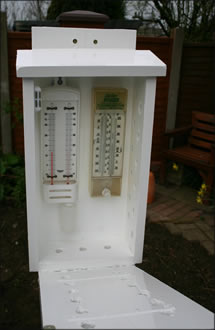 |
Weather box - made from gutteringThis weather box has been designed to house a maximum and minimum thermometer. To see it in use look at the video on the Six's Thermometer Page. As it is made from plastic is does not need to be painted, and should withstand the elements fairly well. To find out how to make it, and what you need, look at the weather_box_guttering file. Remember to be careful with all tools and construct under adult supervision. Remember to make the opening side face north. Check for more details about where you should position your weather box on the Setting Up page. |
|
Weather box - made from plastic trunkingThis weather box has also been designed to house a maximum and minimum thermometer. You can see a video of it in use on the More About Setting Up page. It can be made cheaply and easily. To find out how to make it look at the weather_box_trunking file. Remember that there is a standard height for you thermometers. Check for more details about where and how you should position your weather box on the Setting Up page. |
|
Weather box - digital woodenThis easy-to-make wooden weather box is useful for housing a digital maximum and minimum thermometer, or the sensor for a remote weather station. Check that the sizes are suitable before you make it, and adjust if you need to. This weather box should allow the air to move freely without letting in rainwater. See how to make it in the weather_box_digital file. Check for more details about where and how you should position your weather box on the Setting Up page. Making the door face north means the sun will not shine on the thermometer when the door is opened. |
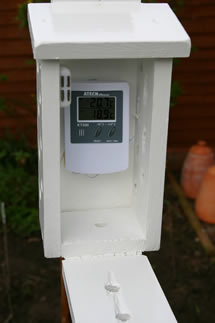 |
Weather screen for digital sensorThis screen can be used to house a sensor from a digital thermometer like the one in the image above. It will keep the sun, wind and rain off the sensor. The actual thermometer will need to be kept elsewhere inside. It is made from white plant pot saucers. The white colour reflects heat from the sun. See how to make it in the weather_box_sensor file. See more about digital weather on the ICT page. |
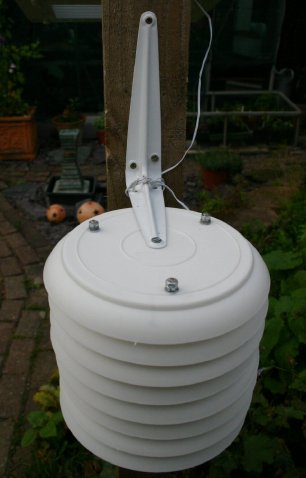 |
